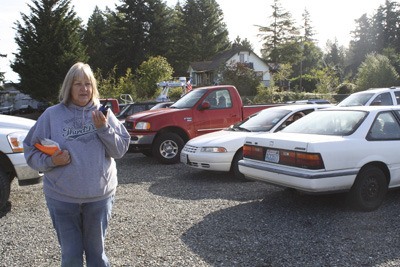For their second day using the new parking system, things were moving along pretty well, if a little slowly, Thursday at the Bonney Lake Food Bank, where the need of the community long ago outgrew the building’s four parking spaces.
“We’re up to over 1,200 families a month over both distribution centers,” said Food Bank Director Stew Bowen.
According to Bowen that’s up about 100 families from this time last year. last month at the main building on Sumner-Buckley Highway alone Bowen said they served 628 families.
“It’s not uncommon to have 20, 25 families waiting when we open,” he said.
But with only a handful of places to park, food bank clients were overflowing into the lots of businesses that surround the building, prompting complaints to the city and discussions with police and administration to find a new way to move cars without disrupting other businesses.
“We’ve been having struggles trying to keep people from parking in inappropriate places,” Bowen said. “They were parking here, they were parking there, they were parking everywhere and we’re trying to get that squared away.”
Beginning Oct. 11, the food bank instituted a new parking policy in which clients are to wait in the city’s large gravel lot located behind the public safety building. Each client gets a number based on when they arrive and are then called up to the building four at a time.
A food bank volunteer with a walkie-talkie is positioned in the lot when the food bank is open to help direct cars and to send clients to the building when the staff is ready for them.
“That way we’ll only have four vehicles in front at any given time,” Bowen said.
Mayor Neil Johnson said he is concerned about the state of the food bank, especially as the economy forces more and more people to need their services. Johnson said the real problem is that the current level of need has simply “outgrown the building,” though he said not all of the increase in need comes from within Bonney lake’s borders.
“I can see the growth and it’s not just in Bonney Lake,” Johnson said.
Johnson said he believes the days of single-city food banks may be coming to an end and a regional solution to the problem is necessary, but said he hopes for now the new parking strategy solves the current parking problems.
“Hopefully this solution will work,” he said.
The only downside of the new plan, as Bowen sees it, is the loss of a sense of community or family that he said came from having so many people waiting in the food bank and fears that having people wait in their cars will create a “disconnect.”
Though there was some initial confusion and some lot organization to still be put in place, the reviews from the first week were not bad.
“I think it worked pretty well,” Bowen said.
Food bank client Mel Fairchild agreed and said he actually liked the new method better.
“It’s not as crowded and it seems to be faster,” Fairchild said. “There’s not nearly the noise or the hassle.”
Not all clients have been as positive as Fairchild, but most are understanding, Bowen said, and he sees this as a better, more manageable system.
“Whenever you do something new it takes some getting used to, both for staff and clients,” he said, “but I think in the end it’s going to be a win-win deal. I really do.”



